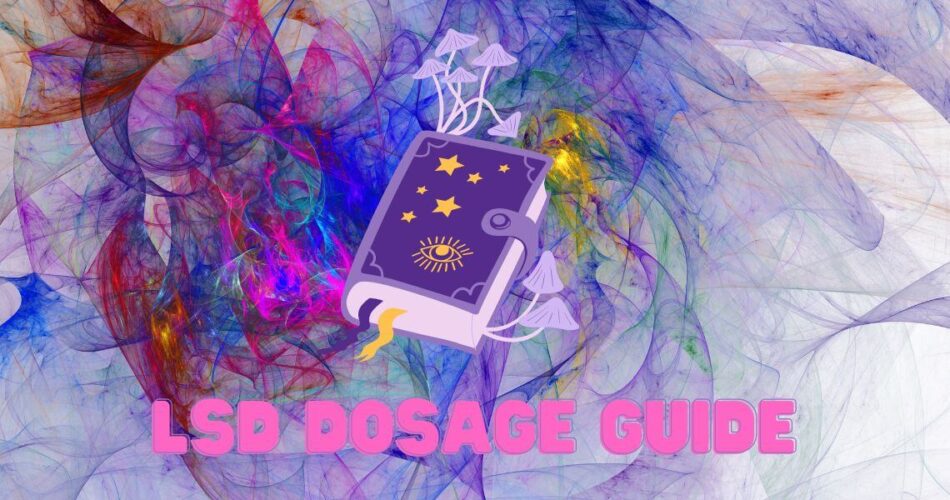LSD, also known as acid, can be a powerful tool for personal growth and healing. But taking LSD at the wrong dose can lead to an unpleasant or even dangerous experience. So it’s important to understand how LSD dosing works. Here’s a quick LSD dosage guide.
KEY TAKEAWAYS
- Microdosing LSD is when a person takes a very small dose of LSD, usually between 5 mcg to 20 mcg.
- This range is considered the “sub-perceptual” range because it typically won’t produce any noticeable changes in consciousness or perception.
- Low doses of 25-70mcg can produce noticeable effects on your consciousness and perception including visuals and an altered sense of time lasting 4–8 hours.
- Doses between 75-150mcg often create more intense visual hallucinations with trip lengths up to 12 hours however there is also an increased risk for negative psychological effects such as anxiety or paranoia.
- High doses 150mcg+ create overwhelming experiences with possible spiritual connections lasting up to 18 hours but also come with greater risks for bad trips characterized by confusion, paranoia, or anxiety.
- Body weight & quality of substance are important factors that affect individual dosage.
LSD: A Powerful Psychedelic
LSD is a powerful psychedelic drug with the potential to significantly change your consciousness and perception. LSD can cause profound changes in your mood and behavior, as well as intense visual hallucinations. LSD doses can range from as low as 20 micrograms to over 400 mcg. But what do these doses mean? Here’s a simple LSD dosage guide.
LSD Dosage Guide and LSD Trips: Microdosing
Microdosing LSD is when a person takes a very small dose of LSD, usually between 5 mcg to 20 mcg. This range is considered the “sub-perceptual” range because it typically won’t produce any noticeable changes in consciousness or perception. But many people claim that LSD microdose has positive psychological benefits, such as increased creativity and improved mood.
Editor’s Note
I was always curious about the effects of LSD, so I decided to research the proper dosage for a safe experience. I learned that a small dose of 10–20 micrograms is considered a “threshold” dose, which is enough to produce a mild effect. Taking a larger dose of 50–100 micrograms can produce a more intense experience, while doses over 200 micrograms can be overwhelming.
It’s important to remember that everyone reacts differently to LSD, so it’s important to start with a small dose and increase gradually if desired. It’s also important to have a sober “trip sitter” who can help if things get overwhelming. With proper preparation and research, LSD can be a safe and enjoyable experience.

Light Trip
LSD dosage guides can help people understand the intensity and duration of LSD trips. At low doses of LSD (25-70 mcg), LSD can produce noticeable effects on your consciousness and perception. You may experience vivid visual hallucinations, heightened emotions, an altered sense of time, euphoria, and a feeling of connectedness with the world around you. LSD trips at these doses can last between 4 and 8 hours.
Medium Trip
For a moderate LSD experience, the LSD dosage guide suggests between 75 and 150 micrograms. The effects are often more intense and profound. LSD trips in this range usually produce very intense visual hallucinations as well as heightened emotions. Trip lengths can also increase to up to 12 hours. The possible negative effects of LSD at this dose can include anxiety, paranoia, and feelings of disconnection from reality.
Strong Trip
At LSD high doses of 150 mcg or more, the effects can become even more intense and profound. The LSD experience in this range can produce very intense visual hallucinations, as well as feelings of unity and spiritual connectedness with the world around you. Trip lengths can also increase to up to 18 hours. This strong psychedelic experience can often be overwhelming, and can come with an increased risk of negative psychological effects such as confusion, paranoia, and anxiety.
LSD Dosage: Body Weight
It’s important to note, that this LSD dosage guide is just a general guide, and LSD dosage can vary greatly depending on the individual. Some people may be more sensitive to LSD than others and may require less LSD for a strong trip. Body weight is also an important factor in LSD dosing, and as a general rule of thumb, someone who weighs less should take less LSD to achieve the same effects.
It’s important to remember that the amount of the substance varies per blotter or tab, and it’s not always the same.
Things You Should Know About Lysergic Acid Diethylamide
The LSD dosage guide provides a general overview of LSD dosing. But LSD can be an unpredictable drug, and it’s important to understand the risks and potential effects before taking LSD. LSD is powerful and can produce intense effects, so it’s crucial to be aware of the dosage and to start with a low dose. LSD dosages can also vary depending on body weight, metabolism, and other factors such as the quality of LSD.
Wondering if you can overdose on LSD? Read our article!
Frequently Asked Questions
What Is the Recommended Dosage of LSD?
The general recommended dosage of LSD is between 5 and 150 micrograms. It is important to be aware that the effects of LSD can vary greatly depending on the individual.
What Is the Maximum Safe Dosage of LSD?
The maximum safe dosage of LSD is not known, as it depends on the individual. Generally, it is recommended to start with a low dose and increase it gradually.
What Are the Effects of Taking Too Much LSD?
Taking too much LSD can lead to a bad trip, which can include intense anxiety, paranoia, and confusion. It can also cause increased heart rate and blood pressure, nausea, and vomiting.
Similar Posts:
- Lethal Dose of LSD (Lysergic Acid Diethylamide) – Is It Real?
- Average Dose of LSD. A Guide to Dosage and Psychedelic Effects
- What Is LSD Measured In? A Dosage Guide to Lysergic Acid Diethylamide
- How Much LSD Is Too Much? Facts About LSD Overdose
- DMT vs LSD: What Do We Know About These Two Psychedelic Substances?
- 1P-LSD – a Legal Version of LSD? | The Unregulated Nuances of 1P-LSD
- How Often Can You Do LSD? LSD Tolerance, Addiction, and Dose




